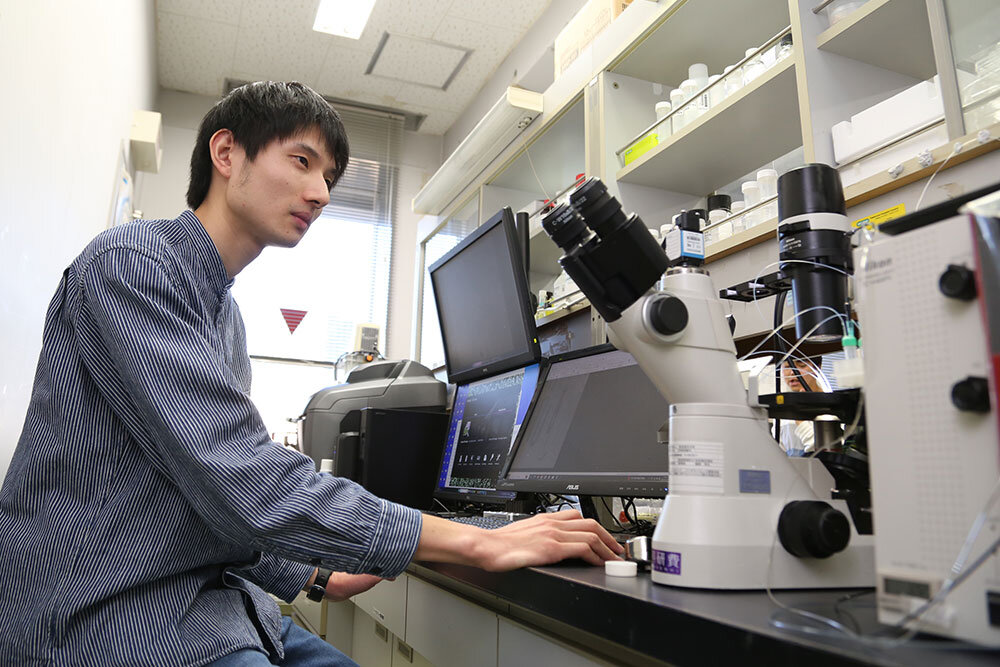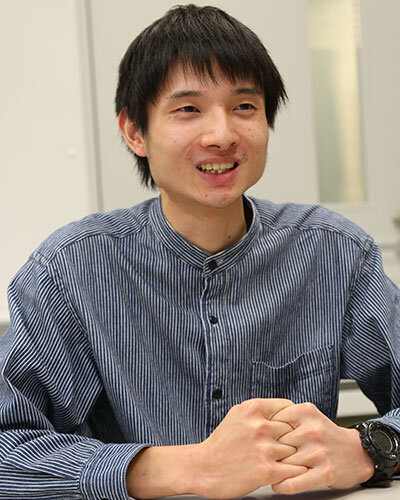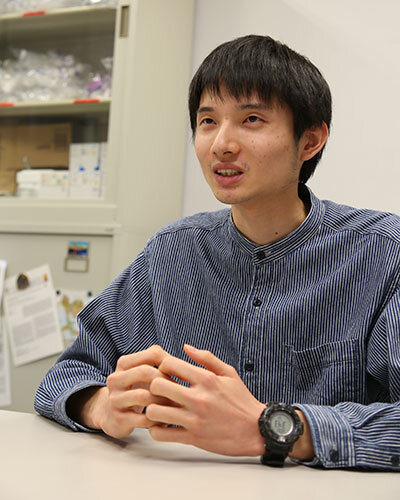INTRODUCTION学生紹介
- HOME
- support
- Student Introduction
- HARADA MASACHIKA
STUDENT INTRODUCTION
Marine Life Sciences
HARADA MASACHIKA
Specializations:Marine Bio Engineering
Main academic advisor:KOIWAI, Keiichiro
Mentor:MIYAMOTO, Ryusuke / YAZAWA, Ryosuke

I hope to stop the damage to Japanese tiger prawn aquaculture from infectious diseases and minimize economic loss
Checking the spread of infectious diseases at Japanese tiger prawn farms to minimize economic loss
I grew up in Kamakura. I spent a lot of time playing by the seaside, and I have always been interested in the ocean and fishery. I entered Tokyo University of Marine Science and Technology, hoping to study in a related field. As an undergraduate, I took many classes on the infectious diseases that affect organisms and learned that farmed Japanese tiger prawns are susceptible to such diseases. This was the impetus for my current research, which is scRNA-seq analysis aimed at classifying the blood cells common to Japanese tiger prawns.
Japanese tiger prawns are farmed around the world, and in fact, they account for the majority of farmed crustaceans. However, the damage from infectious diseases is huge, affecting 40% of total production, the losses from which are said to total US$3 billion per year.
Through this research, I hope to help stop the damage to Japanese tiger prawn aquaculture from infectious diseases and minimize economic loss.
Applying techniques from the medical field to marine products
The blood cells of Japanese tiger prawns are responsible for immunity, but we still don't know many of the types of different cells. My focus is on genes, and I am endeavoring to combine genetic engineering and data analysis to establish a persuasive method for classifying cells.
 I use a technique called single-cell RNA-seq in this research. This is a technology that classifies cells based on information on what genes are active. In addition to classifying cells, it enables the discovery of genes that can be used to distinguish cells and also reveals similarities and differences with other organisms. The single-cell RNA-seq technique is often used in the medical field, but rarely for marine products. This analysis is interesting in itself and reveals a large amount of information. It's also interesting just to consider what kind of information we can obtain, and what kind of research this could lead to.
I use a technique called single-cell RNA-seq in this research. This is a technology that classifies cells based on information on what genes are active. In addition to classifying cells, it enables the discovery of genes that can be used to distinguish cells and also reveals similarities and differences with other organisms. The single-cell RNA-seq technique is often used in the medical field, but rarely for marine products. This analysis is interesting in itself and reveals a large amount of information. It's also interesting just to consider what kind of information we can obtain, and what kind of research this could lead to.
The results of my research are expected to enable a fundamental understanding of immunology in Japanese tiger prawns.
To date, my research has been able to classify the blood cells of King prawns and has revealed genes useful in identifying different cells. This is a crucial discovery for the future investigation of the function of classes of cells, and I feel it will be very useful in my research going forward. I am also comparing these to other organisms. I've compared the three main varieties of Japanese tiger prawn and Drosophila flies. As a result, I discovered that whereas Japanese tiger prawns have similar types of cells, Drosophila flies are quite different. This is important information, as Drosophila cells are often treated on the same basis as those of Japanese tiger prawns. I hope that this research can be applied to other organisms.
I joined the WISE Program because I felt the need for AI in my research
I belong to a biology laboratory at the university, and data analysis is not my area of specialist study. It's often said that data analysis will be crucial in the era to come, and I have made a conscious effort to take classes in this field.
Nevertheless, as I progressed with my research, I recognized the necessity of data analysis and AI and the inadequacy of my past studies. I felt the need to study these fields in a more specialized way, and it was then that my academic advisor recommended the WISE Program, where I would be able to learn more about data analysis and AI, so I decided to join.
Students from a wide variety of fields participate in the WISE Program, and the teachers also come from diverse specializations. Because of the varied nature of the fields represented, I often learn things I have never heard about before. It's really satisfying to be able to learn about the ways that data analysis is used by hearing the hands-on experiences of the teachers.
Classes in the WISE Program are designed to be easy to understand, even for people engaging in AI and data analysis for the first time. There is also a mentoring system, where each student is guided by an expert in data analysis in addition to the academic advisor. The curriculum is easy to approach, even for a beginner. In addition to classes teaching data analysis from the basics upwards, there are also a lot of general classes, enabling students to learn what kind of analysis is used in each field.
My approach to research has changed through internships
 Internships are a feature of the WISE Program. I worked as an intern at Nissui Corporation and IDEA Consultants, Inc. in July and October.
Internships are a feature of the WISE Program. I worked as an intern at Nissui Corporation and IDEA Consultants, Inc. in July and October.
At Nissui, I participated in a project to develop technology to automatically detect parasites in farmed Japanese amberjack. My internship at IDEA Consultants only lasted two days, during which I was involved in an environmental DNA project to investigate what kind of organisms inhabit a marine area by examining DNA extracted from the water, and also to research what was possible by combining this with AI.
Through these internships, I learned the need to make proposals proactively. I also learned the importance of thinking for myself and communicating proposals rather than simply doing as instructed by the teacher. This further led to a change in my approach to my own research, and I feel that my internship experiences were extremely valuable for me.

